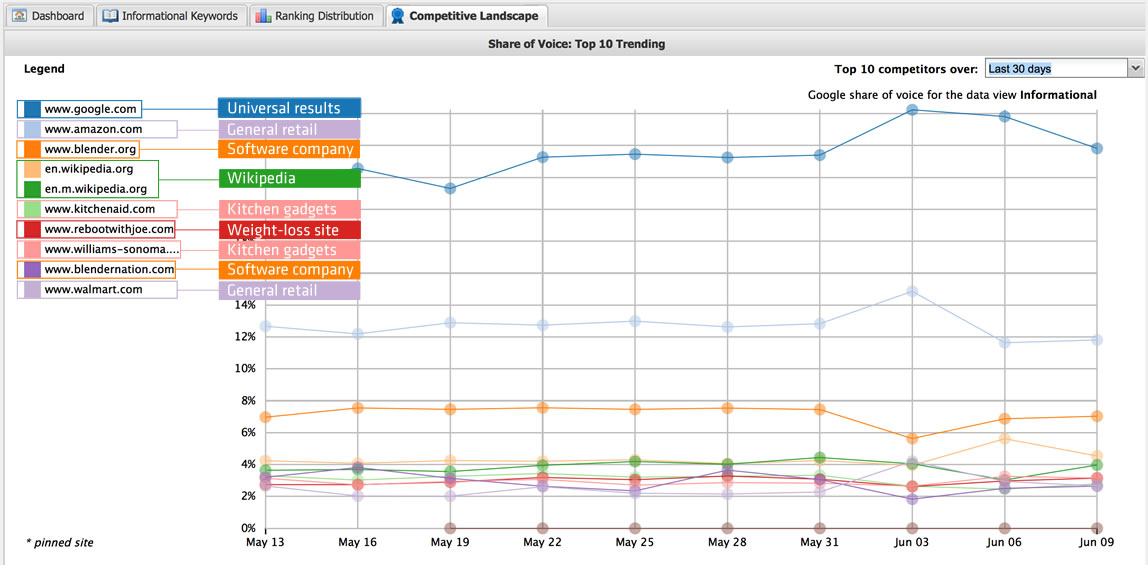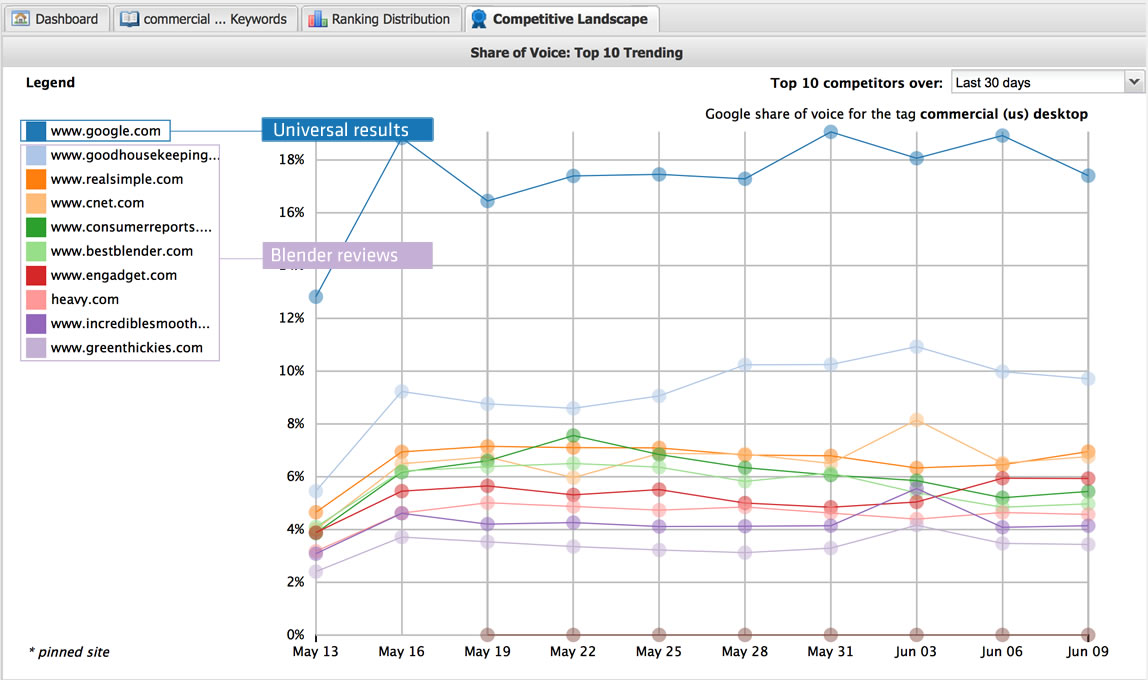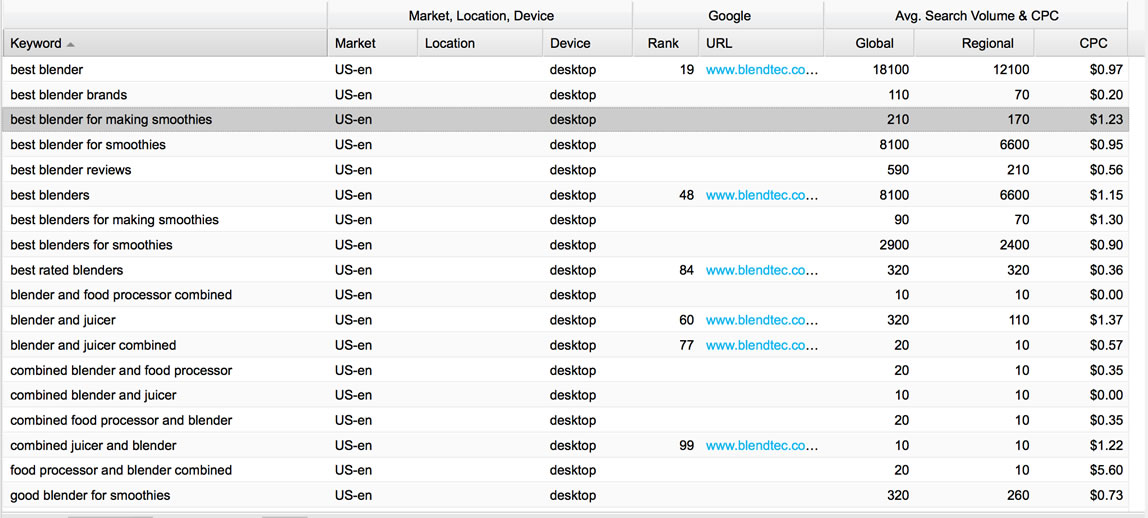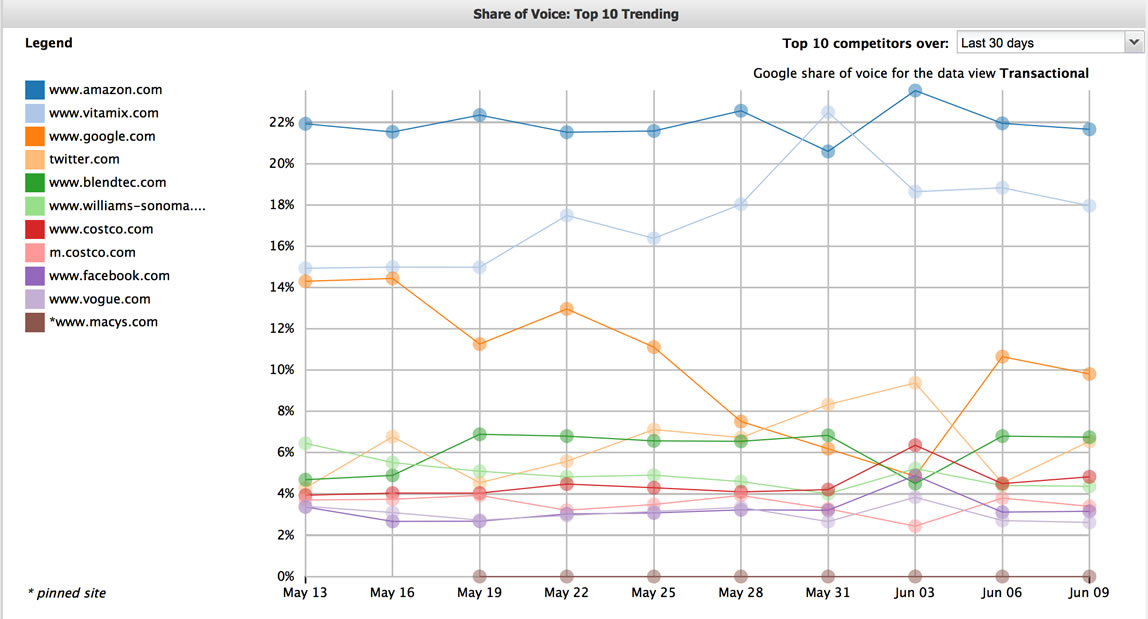By tracking the SEO funnel, you can follow a lead from awareness to purchase, optimizing your content for each step of their journey.
Tracking a lead is traditionally done through a marketing or sales funnel, with SEO supporting many steps along the way. But what if a buyer’s journey starts and stops with a search engine, operating entirely within the SEO sphere?
That sound you just heard? An “SEO funnel” popping into existence.
The SEO funnel
Track how a buyer searches for your products – from start to finish.
Since this funnel focuses on search behaviour, in order to follow a buyer from interest to purchase, you have to track the intent that motivates it — which can be navigational, informational, commercial, transactional, and local in nature.
To illustrate how this SERP tracking strategy might look, we made up Bob. Good ol’ Bob needs to get his hands on the perfect blender for freshly-made smoothie-goodness.
We then created keyword lists for every level of Bob’s search intent, loaded them into STAT, and tracked them in the US, on mobile and desktop, and against the Blendtec website.
We’ll look at a mix of rank, search volume, and share of voice to pick out some high-value keywords that Blendtec would be wise to structure content around.
1. Informational intent
The top of our SEO funnel starts with informational queries — Bob’s very early research into the slicing, dicing world of blenders.
We deem informational queries less likely to convert because we can never know why someone might want to understand, say, the difference between a blender and a juicer. The reason could be as simple as putting an end to a heated dinner-time debate about the functionality of various kitchen appliances.
Even though many of these informational searches rarely result in a direct transaction, you can’t ignore them. If you only focus on the end of a buyer’s journey, you’re optimizing for just a small percentage of searches and missing out on the entire awareness stage of the funnel.
“A searcher is more likely to buy from you if they can learn from you.”
Think about it this way: how will people eventually choose your product if you’re not educating them about it? Getting on the SERP early in the game will help guide the searcher’s next steps. And while search results could guide someone towards or away from you (like a pesky negative review), you can guarantee that a SERP no-show is a strike against.
Creating a keyword list for this first step involves starting at the bottom of the funnel: the conversion. With the goal of a purchased blender in mind, we need to put ourselves in Bob’s shoes and consider how he’ll begin his research.
Maybe Bob’s only slightly confident he needs a blender to make smoothies. Would a food processor or juicer work better? His initial searches might look something like:
[blender]
[smoothie blenders]
[what is a food processor]
[blenders vs. food processors]
[difference between blender and juicer]
Analysis
Let’s head to STAT and check out the informational keyword set. The first place we look is the Competitive Landscape to see who owns the biggest share of voice for these broad informational searches.
Excluding Google’s universal results (stuff like shopping boxes and images of various blender brands), the results are not what we’d expect: four of the top nine websites have nothing to do with blenders; two are general retail; two sell various kitchen gadgets; and one is a weight-loss site with a focus on juicing.
Who has informational queries on lock-down?
There’s a great opportunity for Blendtec to gain some ground at the top of the funnel.
In other words, Blendtec — nor any of their blender-only competitors — doesn’t make the list.
Recommendations
No share of voice in this section means that Blendtec isn’t educating potential consumers at the top of the funnel particularly well. They would benefit from either a buyer’s guide, FAQ page, or other static content that answers the high-level questions searchers might have about blenders.
Build the content to get the traffic.
Blendtec must build top-of-funnel content to pull in the looky-loos.
These easy-to-find, indexed pages will help both searchers and search engines find matches for the informational queries, as well as keep searchers on the Blendtec website while they learn about blenders. Plus, visitors think more favourably on brands that educate them on their needs.
The keyword [smoothie blender] would be a good target because of its high search volume and specificity, which indicate higher buyer intent.
The keywords [blender vs. food processor] and [difference between blender and juicer] are worthwhile for the same reasons as [smoothie blender], and because many blenders are a combination of those appliances or compete against them.
Blendtec’s website actually has several Q&A sections and blog posts that help answer informational questions, but they could be better optimized and linked throughout, or integrated into a single FAQ section.
Yes, but does it juice?
This screenshot taken from a blog post on Blendtec’s website shows that their visitors do indeed ponder about a blender’s juicing capabilities, ie. [blender vs. juicer].
2. Commercial intent
Our next step in the SEO funnel is commercial intent. This is a bit of a contentious category, with many SEOs choosing only to focus on informational and transactional, and others considering commercial to be synonymous with transactional, or a subset within it.
But the way people search is far too complex for only two search intents, so we like to separate out commercial keywords. Rand Fishkin from Moz describes commercial investigations as “not directly transactional, and may never result in an exchange of goods, services or monies, but they’re not purely informational either.”
In this stage of the SEO funnel, searchers are doing comparative research and looking for specific requirements. As a result, education is still the top priority here. Being a voice of authority with a strong SERP presence creates trust and brand affinity with the searcher.
Bob’s blender queries might be something like:
[quiet blenders]
[top rated blenders]
[heavy-duty blender]
[best blender for smoothies]
[combined blender and juicer]
Analysis
Looking again at STAT’s share of voice for the commercial intent keyword list, we see an almost entirely different set of competitors from the informational set. And once again, Blendtec doesn’t make the list.
Commercial intent is owned by review sites.
Don’t rely on other websites to educate potential customers on your products.
Most of the top 10 sites that are winning share of voice are content-heavy and focus on reviews. The problem that Blendtec faced at the top of the funnel has, well, funneled down into this stage as well — they’re relying on other websites to educate searchers about their product.
Recommendations
Blendtec has a “Compare Blenders” section on their website, which is a step in the right direction but doesn’t quite go far enough — only comparing things like horsepower and warranty. (Have you ever searched for the horsepower of a blender? Us neither.)
Looking through the Q&A sections again, we find other kinds of blender comparisons and lists that could be repurposed and added to their shop section, blog, and product descriptions. One such example is [quiet blenders], which has a search volume of 880 and Blendtec currently ranks 45th for.
Questions galore!
Some questions buried deep on one of Blendtec’s product pages to build content around.
Picking keywords in this category to build content around gives us a great opportunity to have an honest discussion about search volume and why, if you’re not careful, making it your primary focus could lead you astray.
We know that generally, more web traffic means more leads, and that a high search volume keyword will generate more traffic for its top ranking sites — but not all web traffic is created equal.
So while it might be tempting to rid yourself of keywords with low search volumes, a little more consideration is required. Take the keyword list below for instance:
Specificity means higher intent.
Long-tail search queries, even with a lower search volume, shouldn’t be overlooked.
The query [best blender for making smoothies] has a regional search volume of 170. This may not carry the same search weight as [blenders] with its 823,000 monthly searches, but it does show greater buyer-intent due to its specificity. Long-tail keywords make up for their lower search volumes with higher conversion rates.
“Help turn a searcher’s commercial intent into a conversion with content geared towards their comparative research and refined requirements.”
Another example is the query [food processor and blender combined]. It has an incredibly low regional search volume of 10 but is also the highest CPC keyword in the entire set. This could indicate that it’s a high-converting keyword and another term that Blendtec might want to incorporate into their content.
3. Transactional intent
Finally we’ve reached the bottom of our SEO funnel, where the searcher is on the precipice of purchase.
Transactional queries are the most likely to convert and generally include terms that revolve around price, brand, and location, which is why navigational and local intent are subsets within this stage of the SEO funnel.
Of course, it’s impossible to know if keywords have the exact intent we ascribe them (does [top blenders] imply transactional intent instead of commercial?), but drawing a line in the sand is the best we can do.
Here, Bob’s searches might look like:
[blender prices]
[top cheap blenders]
[Blendtec blender reviews]
[Blendtec Professional 800 cost]
[Blendtec blenders San Francisco]
Analysis
Hopping one last time into share of voice, it’s nice to see Blendtec appear for the first time in our top 10, but surprising to see them with less share of voice than Amazon — especially given that much of this keyword set is made up of their branded queries. This positions Amazon as a huge competitor here, which requires a little further investigation.
Blendtec finally joins the top 10 party.
But Amazon has a firm grasp on the biggest share of voice. To find out how, we look at STAT’s archived SERPs.
Clicking over to STAT’s Archived SERPs subtab, we can see exactly which Amazon URLs are appearing for these keywords and capturing this large share of voice. Following the links, it appears that Blendtec actually has a store on Amazon.
Recommendations
With this new information, Amazon is less of a competitor and more of an ally in battle of the SERPs. Since Blendtec is in control of their Amazon store, optimizing those product pages for both keywords and conversions is essential.
Of course, it’s important to remember that Amazon is not beholden to Blendtec and sells many other brands of blenders, so it’s still in Blendtec’s best interest that their website be a strong competitor in this category.
“Highly converting keywords should drive traffic to highly converting landing pages.”
When picking keywords that Blendtec might want to target at this stage of the SEO funnel, we segmented out price-related queries for a closer look. It appears that Blendtec doesn’t garner any rankings while Amazon, on the other hand, ranks for every single one with various blender brands.
This could be intentional on Blendtec’s part — not worrying about the connotative meaning of pricing language in their content — but when [cheap blenders] has a regional search volume of 1,300 and [best affordable blender] has one of 260, pricing is a topic worth fighting Amazon for.
As an interesting side note, even though “cheap” sounds, well, cheap, it out-performs “affordable” in terms of search volume every time. In other words, people aren’t beating around the bush when it comes to finding the right price.
3.1. Navigational intent
We’ve put navigational queries — meant to locate a specific website — within transactional intent because they have high buyer intent, show brand recognition, and can also indicate returning customers. Bob can only be searching for [Blendtec blenders] if he already knows about Blendtec.
Analysis
Given that navigational intent consists of branded queries, it’s important that a company rank well for this category, which Blendtec succeeds handily at.
Recommendations
We don’t really have any recommendations here. Good work, Blendtec. Keep it up!
3.2. Local intent
Local intent is when the searcher plans to do or buy something locally. We’ve included local search within the transactional intent section of this SEO funnel (it can appear earlier depending on the subject being tracked) because a searcher would only be interested in seeing a blender first-hand if they were thinking of purchasing one.
For example, Bob might search [Blendtec blenders Macy’s San Francisco], if he lived next to the Macy’s and wanted to shuffle across the street to press a few blender buttons and avoid paying for shipping.
Identify search patterns to feed directly into SERP tracking strategies that specifically address the unique needs of various industries and verticals.
When you factor your location in with the number of retail stores and products you have, as well as the strength of a searcher’s purchasing intent and the type of device they use, you’re faced with an endless number of ways to tag and track your data.
We were so fascinated by how all of these factors contribute to a local search that we went ahead and wrote a guide on tracking different local search patterns to help you get a competitive edge. We’d classify Bob’s searches as either the “Armchair Researcher” or “I want it now” pattern.
Recommendations
If you function both as an e-commerce and brick-and-mortar store, you’ll want to duplicate the transactional keywords, add appropriate local search terms (street name, intersection, neighbourhood) to the new list, and then track them in tandem.
This is the perfect way to monitor each of your store locations and find yourself searching for big data providers after your keyword count suddenly explodes.
So, are you ready to tag and track your own SEO funnel with a little help from a friend? Say hello and request a demo!









